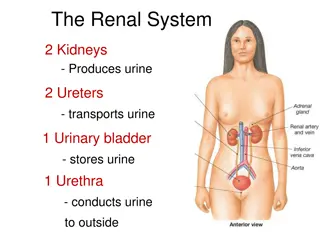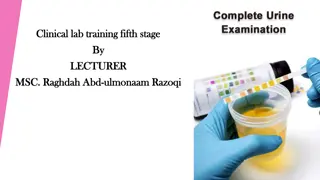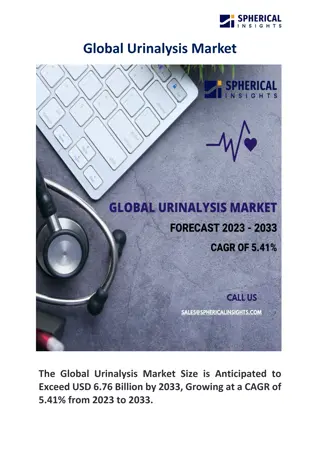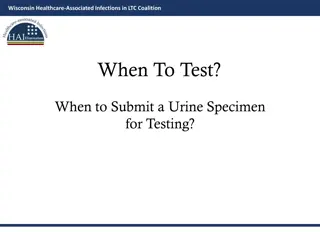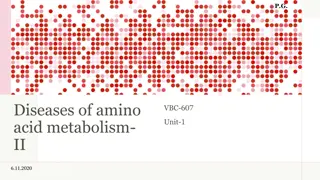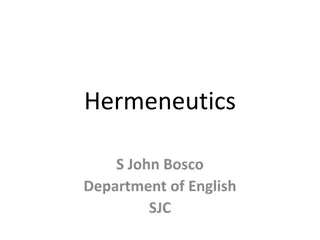Understanding Urinalysis: Importance and Interpretation of Urine Analysis Parameters
Urinalysis is a crucial diagnostic tool that provides valuable insights into various health conditions through the examination of urine physical and chemical properties. This examination helps in detecting abnormalities such as diabetes, renal failure, dehydration, and infections. By understanding the normal and abnormal ranges of parameters like volume, appearance, color, odor, pH, proteins, glucose, and blood in urine, healthcare professionals can make accurate diagnoses and devise appropriate treatment plans. Stay informed about the significance of urinalysis to maintain optimal health.
Download Presentation

Please find below an Image/Link to download the presentation.
The content on the website is provided AS IS for your information and personal use only. It may not be sold, licensed, or shared on other websites without obtaining consent from the author. Download presentation by click this link. If you encounter any issues during the download, it is possible that the publisher has removed the file from their server.
E N D
Presentation Transcript
Biochemistry Practical URINALYSIS To know what have we changed check our Editing file Your body hears everything your mind says .. Stay Positive Important. Doctors slides
Notes about the exam : 1. This work is not by any means a reference . 2. As the doctor said the exam will consist of a urinalysis case, and it will be similar to the sample you did in the lab, but instead of finding the features some of it will be given, and there will be a question on the diagnosis of the case .. 3. Do your best and it will be so easy
U R I N E : What is urine ? Urine is a fluid excreted by most of mammals including humans . It is formed in : the kidneys (renal glomeruli) . Urine Excretion : -The fluid undergoes chemical changes before it is excreted as urine. -Normal urine excretion by a healthy person is about 1.5 L per day .
Physical Properties Of Urine IMPORTANT PARAMETER NORMAL ABNORMAL POSSIBLE CAUSES Diabetes , chronic renal failure Dehydration , Acute renal failure Presence of pus cells , bacteria , salt or epithelial cells Polyuria Oliguria Volume 0.4-2.0 L/day Appearance Clear Cloudy Excessive fluid intake , uncontrolled DM* , DI** , chronic renal failure Dehydration , carotenoid ingestion Jaundice Blood , drugs etc. Methemoglobin , alkaptonuria , melanoma , black water fever glomerulonephritis Diabetic ketoacidosis Contaminated and long standing exposed urine Phenylketonuria Colorless *Diabetes Mellitus **Diabetes insipidus Orange Yellow-Green Red Color Pale Yellow Dark brown-black smoky Fruity Ammoniacal Mousy Burnt sugar Crystals, salts or cells Odor (Smell) Urineferous Maple syrup urine disease Deposits Blood clots , necrotic tissues and urinary stones None ketosis (diabetes mellitus & starvation) , severe diarrhea , metabolic and respiratory acidosis , excessive ingestion of meat and certain fruits Acidic Reaction (pH) 4.6 - 7.0 Respiratory and metabolic alkalosis , Urinary tract infection , Vegetarians Alkaline
Chemical Properties of urine IMPORTANT PARAMETER NORMAL ABNORMAL POSSIBLE CAUSES Nephrotic syndrome , glomerulonephritis , multiple myeloma , lower UTI , tumors or stones Protein < 200mg/day Proteinuria Uncontrolled DM , gestational diabetes , Fanconi s syndrome Glucose None Glucosuria Diabetic ketoacidosis , Glycogen storage disease, starvation , Prolonged vomiting , Unbalanced diet: high fat & Low CHO diet Ketones None Ketonuria UTI Nitrite None Detected Bilirubin None Detected Hepatic and post-hepatic jaundice Normal Trace (1mg/dl) Urobilinogen Jaundice > 2 mg/dl Acute & chronic glomerulonephritis , Trauma , cystitis , renal calculi and tumors , Bleeding disorders (Hemophilia). Hematuria Blood None Hemoglobinopathies , Malaria , Transfusion reaction (Blood Incompatibility) Hemoglobinuria
Nephrotic syndrome PROTEINS Large amounts of protein are lost in the urine and hypoproteinemia develops. Normally less than 200 mg protein is excreted in the urine daily More than this level leads to a condition called (Proteinuria). Increase protein excretion in urine can be one of the following two types: A: High Molecular Weight Protein Excretion: Glomerular proteinuria due to increase glomerular permeability leading to filtration of high molecular weight proteins Glomerular Proteinuria It is due to Filtration of high molecular weight proteins ( e.g. glomerulonephritis) glomerular permeability B: Low Molecular Weight Protein Excretion: excretion of low molecular weight proteins (e.g. chronic nephritis) Tubular proteinuria It is due to Tubular reabsorption with normal glomerular permeability Tubular proteinuria due to decrease reabsorption with normal glomerular permeability
Urinalysis (using dipstick): Principle: Procedure: Dipsticks are plastic strips impregnated with chemical reagents which react with specific substances in the urine to produce color-coded visual results. 1. Dip the strip in the urine sample provided then remove it immediately. 2. Remove the excess urine and keep the strip in a horizontal position. They provide quick determination of pH, protein, glucose, ketones, urobilinogen, bilirubin, blood, hemoglobin, nitrite, and specific gravity. The depth of color produced relates to the concentration of the substance in urine. 3. Read the color produced within 30-60 seconds (Color changes after more than 2 minutes are of no significance). 4. Match the color changes to the color scale provided. Color controls are provided against which the actual color produced by the urine sample can be compared .The reaction times of the impregnated chemicals are standardized. 5. Give a full report about: - Physical examination - Chemical examination
CASE I Usually under 25 years patient with type I diabetesWhen there is no enough Insulin,the patient can not use the glucose as afuel so the body breaksdown fat instead, lead toacid (ketones) build up. A 12-year-old girl, a known patient with T1DM, presented to Emergency drowsy with short history of vomiting and abdominal pain. On examination: - Tachycardia - Tachypnea with a fruity smell of breath. Diagnosis is very important - BP: 85/50 mmHg (Ref range: 100/66-135/85 mmHg) Diabetic with ketonuria (diabetic ketoacidosis) - Blood sugar: 26.7 mmol/L (Ref range: 3.9-5.6 mmol/L) - HbA1C: 9.9% (Ref range: 5.7-6.4%) - Blood pH: 7.1 (Ref range: 7.35 7.45) - Circulating Ketone bodies: positive A mid stream Urine sample was collected for complete urinalysis. Important characteristics: What are the Physical Properties of Urine.? Polyuria, Fruity Odor, Acidic PH, colorless (usually the rest are normal) What are the Chemical Properties of urine? Ketonuria, Glucosuria elevated amount of keton and glucose in urine . (usually the rest are normal)
CASE II UTIpatients usually have: 1- Pain or burning feeling duringurination. 2-feeling ofurgency. 3- feeling the need to urinate frequently. 4- altered appearance of the urine,either bloody (red) or cloudy. 5- pain or pressure inthe rectum. A 49-old woman with history of DM came to hospital with fever, weakness and dysuria (pain during urination) for the last threedays. The results of her laboratory tests were as the table below. A mid stream Urine sample was collected for completeurinalysis. Microscopic examination of urineshowed:- WBCs: over 100/HPF (Ref range:2-3/HPF) RBCs: 10 /HPF (Ref range:0-2/HPF) Diagnosis is very important Urinary tract infection Test Result Reference range Fasting blood glucose 7.5 3.9-5.8mmol/L Creatinine 75 55-120mmol/L Urea 3.7 2.5-6.4mmol/L Sodium 140 135-145mmol/L Potassium 3.9 3.5-5.1mmol/L Important characteristics: What are the Physical Properties of Urine? (Alklaine, cloudy) (usually the rest arenormal) What are the Chemical Properties of urine? (Proteinuria, Hematuria, Nitritedetected) (usually the rest are normal)
CASE III Nephrotic Syndrome Is A Kidney Disease With: Proteinuria Hypoalbuminemia Edema Hyperlipidemia Hypercholesterolemia A 6-year-old boy, developed marked edema over a period of few days. His mother had noted puffiness around the eyes, characteristically in the morning. She also noted that his urine hadbecome frothy His general practitioner ordered the following investigations (in the table below): A BLOOD sample was collected to show the following Diagnosis is very important Test Result Reference range creatinine 58 55-120mmol/L Nephrotic Syndrome Urea 3.4 2.5-6.4mmol/L Sodium 136 135-145mmol/L Potassium 4.0 3.5-5.1mmol/L T otalProtein 34 60-80g/L Albumin 14 35-50gmL Cholesterol 11 3.2-5.2mmol/L Triglycerides 1.5 0.5-2.27mmol/L The blood sample shows hypoalbuminemia and hyperlipidemia = Nephrotic Important characteristics: What are the physical properties ofurine? Frothyurine. (usually the rest are normal) What are the Chemical Properties ofurine? Heavyproteinuria. (usually the rest are normal) Urine dipstick must show proteinuria SYMPTOMS: 1. 2. 3. Frothy urine Puffiness around the eye Edema
THANK YOU FOR CHECKING OUR WORK Done By: MUHANNED ALZAHRANI


